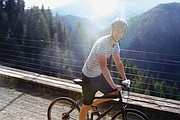Riding the Hiawatha
Last Wednesday, I decided, on a whim, to ride a portion of the 15 mile Route of the Hiawatha bike trail, just off of I-90 along the Idaho-Montana border.
My motivation was two part: professional and personal.
To be honest, I had little choice in the matter as the article was suggested by my publisher and assigned to me by my editor, but, in an entirely semantic sense, I chose to accept the challenge along with my fellow reporter Trevor.
Secondly, having recently moved to Montana, I told myself that I didn’t make the trip just to sit on my couch and watch Jersey Shore.
Besides, I thought, it would be an easy story to write and an excuse to get some exercise.
I found the ride, however, to be a little more trouble, and a little less work than I expected.
After getting a late start, by losing our way in the windy back roads of the Bitterroot Mountains, and after coming to grips with the mediocre status of our cardiovascular endurance, Trevor and I decided not to ride the full length of the 30-mile round trip trail.
Instead, we settled on what we believed was one of the more scenic sections of the journey, between the Moss Creek and Pearson trail heads. What we saw was in no way a disappointment.
The Route of the Hiawatha is named for the old Olympian Hiawatha passenger trains of the Milwaukee Road railroad which formerly ran along the trail’s route.
As we rode, we tried to imagine what it would have been like to enjoy the panoramic view from a seat in a speeding train.
Trevor, who is actually quite the amateur photographer, passed up no occasion to immortalize the rustic mountain landscape, while I found myself mesmerized by the interpretive historic landmarks that speckled the trail.
The signs painted the picture of the railroad’s historic run. Their anecdotes spanned the railroad’s entire functional life, from it’s construction in 1906, to the Milwaukee Road’s declaration of bankruptcy in 1977, until the line was abandoned after the final train west of Butte passed through in 1980.
Included were hardships and calamities faced by those who built and operated the railroad, as well as stories of the many locals who fled to the rail-cars and were transported to safety during the catastrophic fires in the summer of 1910.
I was so enthralled by the rugged beauty and rich history, that I barely noticed the growing distance between Trevor and myself. I found myself having to pedal much harder than Trevor, who seemed to effortlessly coast both up and downhill as I labored in a failing attempt to keep up.
Since I knew Trevor to be an avid biker, I first questioned my physical ability to keep up with him. But several objections from my ego, and the faint smell of burning rubber prompted me to reconsider. Upon examining my front brakes I noticed that they were permanently engaged, and riding the rim of my tire. This both soothed my ego, and after loosening the brake line, quickened my pace for the remainder of the trip.
As you can imagine, my solution to disconnect the break solved one problem while causing another, and certainly made my descent down the mountain a little quicker, and a little more exciting than I had originally anticipated.
The trail weaves its way through 10 cavernous tunnels and over seven high bridges as it dances up and down the mountains along the Idaho-Montana border.
As our legs grew heavy, and the sun began to sink ever lower on the horizon, Trevor and I knew our afternoon in the sun was coming to an end. After turning around and beginning to make our way back to the car we both realized that the memory of this bike ride would stay with us longer than the stiffness in our muscles, or the bugs that were caught between our teeth. By the time we arrived back at the car, we knew why the “Route of the Hiawatha” had been called the “crown jewel” of mountain-bike trails.



